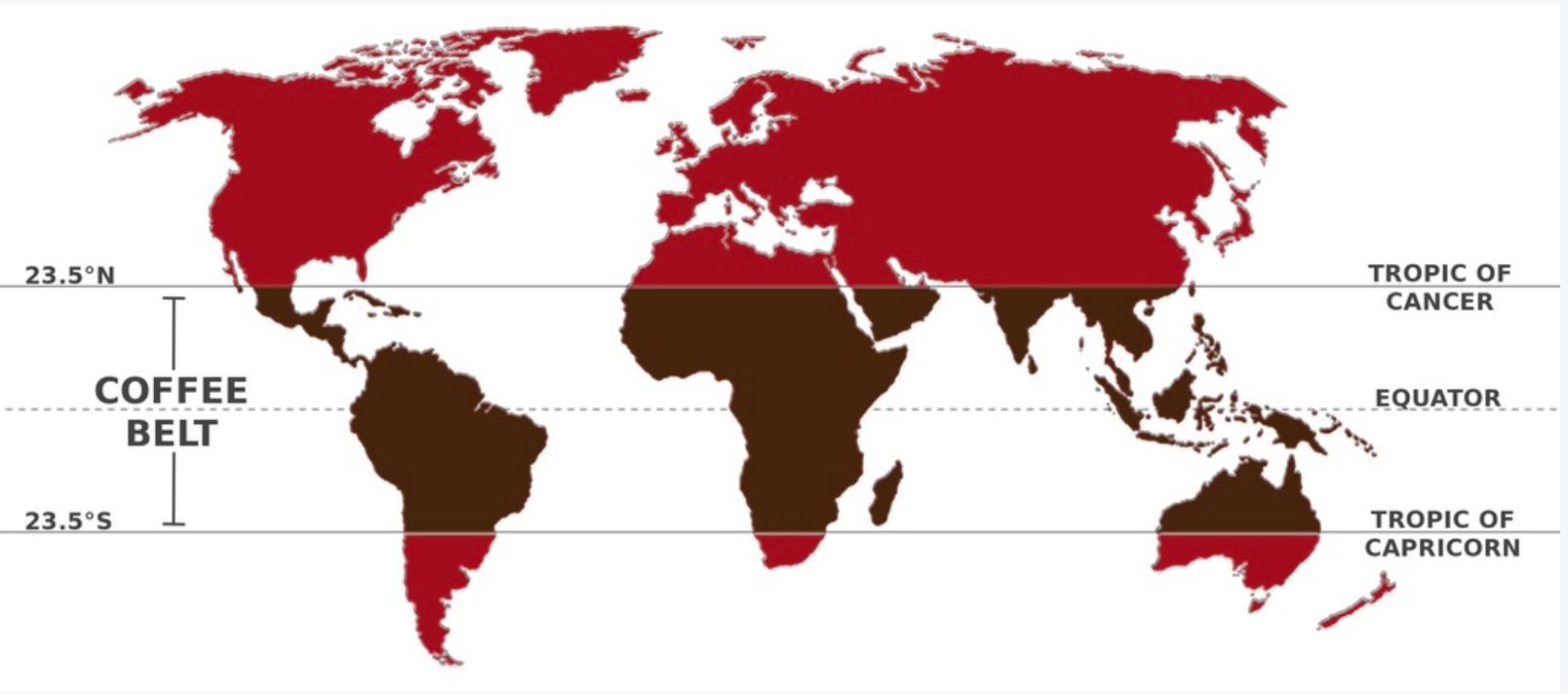
In this article, Camille KELLER (ESSEC Business School, Bachelor in Business Administration (BBA), 2020-2024) explores coffee as a commodity and cultural staple.
Coffee is more than just a beverage; it is a universal ritual, an economic cornerstone, and a cultural staple. As one of the most traded commodities in the world, coffee fuels not only mornings but also economies. In this post, we will explore the many faces of coffee, the countries that produce it, and the industry’s global composition, setting the stage for a deeper understanding of its role in global markets.
The different types and varieties of coffee
Two primary species dominate the coffee market: Arabica and Robusta. Arabica constitutes approximately 60-70% of global coffee production as of 2023, according to the International Coffee Organization. Known for its mild and nuanced flavors, Arabica thrives in high-altitude regions with cooler climates. In contrast, Robusta, which is hardier and more resistant to pests, grows at lower altitudes and features a bolder, more bitter flavor, with nearly double the caffeine content of Arabica. Lesser-known species such as Liberica and Excelsa contribute unique flavor profiles. Liberica is renowned for its smoky and floral notes, while Excelsa delivers tart, fruity nuances, though both occupy a niche share of the global market.
Coffee’s quality and flavor depend not only on its species but also on how it is processed. Washed or wet processing produces clean, vibrant flavors and is favored for specialty-grade coffee. Natural or dry processing offers fruity, full-bodied profiles as beans dry inside the coffee cherry. The honey process, a hybrid method, balances sweetness and acidity. Specialty coffee, graded on a scale of 100 points by organizations like the Specialty Coffee Association, stands apart from commodity coffee due to its superior flavor, sustainability practices, and traceability.
Coffee mug

Source: Shutterstock
Mapping the world of coffee: key producing countries
The global coffee market relies heavily on a few key players. Brazil is the world’s largest coffee producer, accounting for 39% of global output. Its diverse climate supports both Arabica and Robusta cultivation, with highly mechanized farming methods. Vietnam, the second-largest producer, specializes in Robusta and contributes around 16% of global production. Known for its efficient, high-yield practices, Vietnam is one of the main players in the coffee industry. Colombia, renowned for its high-quality Arabica beans, benefits from mountainous terrain and ideal climate conditions that produce coffee with bright acidity and rich aroma. Indonesia offers coffee with distinct earthy and spicy notes, thanks to unique wet-hulling processes. Ethiopia, often called the birthplace of coffee, produces some of the world’s most sought-after Arabica beans, featuring floral and fruity profiles.
Emerging players like Rwanda, Guatemala, and Honduras are carving out a reputation for high-quality specialty coffee. These countries are gaining recognition in global markets for their unique flavor profiles and commitment to sustainable practices. The global coffee industry thrives on this diverse production landscape, where each region’s distinct climate, soil, and methods contribute to the variety of coffee available to consumers.
Source: The Coffee Belt Map

Source: melacoffee.com
The industry landscape: big players and composition
Coffee’s journey from farm to cup involves a complex supply chain. Smallholder farmers account for over 70% of global coffee production, often working within cooperatives to improve their market access and bargaining power. Exporters act as intermediaries, facilitating the sale of raw coffee to international buyers. Roasters then transform green coffee beans into the aromatic, roasted coffee that consumers recognize, while retailers, including cafes, supermarkets, and e-commerce platforms, serve as the final link between coffee and the end consumer. Certification organizations like Fair Trade and Rainforest Alliance play a critical role in promoting sustainable and ethical practices across the supply chain, ensuring that the industry’s growth does not come at the expense of its workers or the environment.
A few multinational corporations wield significant influence over the coffee market. Nestlé, with its Nescafé and Nespresso brands, dominates the instant coffee and capsule markets. JDE Peet’s, home to brands like Jacobs, Douwe Egberts, and Peet’s Coffee, is a key player in retail coffee. Starbucks, known for its premium offerings, sets global trends and boasts a vast retail footprint. These corporations drive innovation, shape consumer preferences, and impact coffee prices through their purchasing power and marketing strategies. The industry’s composition reflects a delicate balance between the efforts of small-scale farmers and the strategies of large-scale corporations, each playing a vital role in coffee’s global narrative.
Why should I be interested in this post?
Coffee’s journey from farm to cup involves a complex supply chain. For students of ESSEC interested in global economics, commodities, or sustainable trade, understanding the coffee industry offers key insights into market dynamics, sustainability, and global commerce.
Related posts on the SimTrade blog
▶ Mathis DIALLO The cocoa production
Useful resources
International Coffee Organization (ICO)
Specialty Coffee Association (SCA)
About the author
The article was written in January 2025 by Camille KELLER (ESSEC Business School, Bachelor in Business Administration (BBA), 2020-2024).
